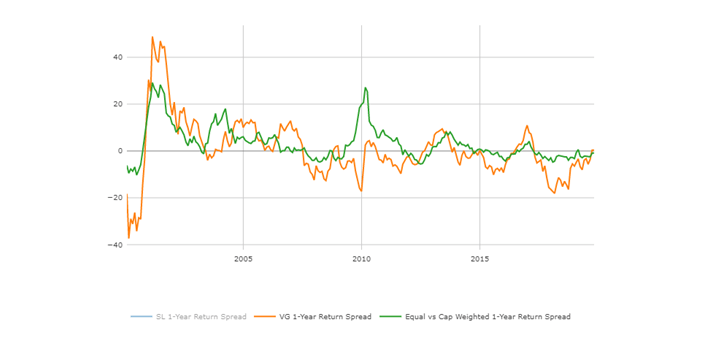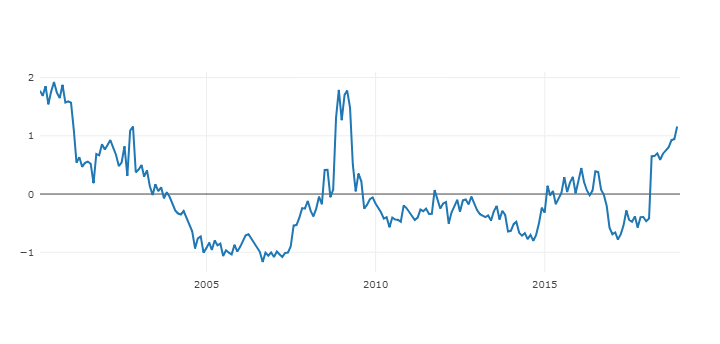In a time of accelerated global growth, we believe investors can benefit from foreign exposure. Valuations in Europe, Japan, and emerging markets (EM) all look cheap relative to the U.S.
Despite the US Federal Reserve (Fed) raising rates, we believe bonds may prove resilient.
We expect the risk of a pullback in equity markets to continue, but we also believe the odds of a new bear market are low – PIMCO estimates 10% or less chance on recession over the next 12 months.
The importance of having an asset allocation well suited for your objectives and risk tolerance, as well as being able to focus on the long term, cannot be overemphasized.
Trend
Overall returns in August were unusual. On one hand, strong performance in safer assets like longer-term Treasuries and weak returns from small caps and value styles suggest there was a flight to safety by investors. Yet one of the best performing sectors was the riskier emerging markets sectors.
Going into September, which historically can be a tough month, we are encouraged by the solid global returns of most asset classes in August. The markets have shown a surprising level of stability given geopolitical and economic risks.
Opportunities
Healthy earnings growth suggests that there is still upside in U.S. equities.
Our quantitative analysis helps identify companies with characteristics that blend multiple factors, including growth, value, quality, and safety. We are currently focused on companies growing at above-average rates while their stocks are selling at discount prices. This strategy is known as growth at a reasonable price, or GARP.
In a time of accelerated global growth, we believe investors can benefit from foreign exposure. Valuations in Europe, Japan, and emerging markets (EM) all look cheap relative to the U.S. Even after strong returns overseas over the past 12 months, we believe there are still investment opportunities available. Long-term investors may want to increase their focus on markets outside of the U.S. We expect EM outperformance to continue, in particular. EM earnings are accelerating and valuations look attractive, in our opinion.
Floating rate bank loans still deserve consideration in a diversified bond allocation. We believe they offer attractive income and lower duration relative to investment grade bonds, and lower volatility than high yield bonds.
The prospects for tax reform are improving, in our opinion. There is much work to be done and we need additional clarity, but given that President trump and Congressional Republicans are desperate for any sort of legislative win, we expect they will be able to come together on a modest tax reform proposal. This could provide a boost to equity markets, particularly smaller caps.
Volatility could be an opportunity. We would likely see market weakness as a buying opportunity. We firmly believe active management can benefit from volatility by uncovering attractive investment opportunities.
Risks
Some investors tell us that they are nervous about markets, partly due to politics, but also on concerns that markets are expensive and the bull market is getting old. Recession is the key consideration. Markets tumble at times, but have a way of coming back, as long as the economy continues to grow. However, when pullbacks are accompanied by recession, they are typically more concerning.
We expect the risk of a pullback in equity markets to continue, but we also believe the odds of a new bear market are low – PIMCO estimates 10% or less chance on recession over the next 12 months.
Although the specific timing and cause of the next recession is unknown, we are scrutinizing 4 key risks:
1. Geopolitical – North Korea continues to fire missiles, prompting response from U.S.
2. Politics – Washington is chaotic, and the drama surrounding President Trump is unlikely to go away. This raises the potential for a showdown over the U.S. debt ceiling.
3. Valuations – Equity valuation levels are getting stretched. U.S. economy is late cycle.
4. U.S. Federal Reserve meetings – The concern is if the Fed hikes rates faster than anticipated.
Outlook
We believe fundamentals suggest this equity bull market is not approaching an end. Economic growth remains decent, earnings are improving and we see no signs of the speculative froth that typically mark the ends of bull markets.
Sure, there are economic risks as well as geopolitical risks, that make us uneasy. However, we are not at the point where we believe it makes sense to get defensive. Rather, we prefer to be selective. We don’t feel that investors can rely on a rising tide of market data to lift all boats. Looking forward, our long-term expected returns are not very high for the broad stock and bonds markets. This makes it important to use active management to identify opportunities for income and capital gains and to control periods of volatility that may arise.
The coming months may require some patience and discipline. We believe volatility is likely to climb, but also believe equity prices are likely to advance unevenly over the coming year
Final thoughts
The importance of having an asset allocation well suited for your objectives and risk tolerance, as well as being able to focus on the long term, cannot be overemphasized. We can help investors decide on an appropriate asset allocation, stay the course during periods of disappointing results, and carefully weigh the considerations mentioned above to help investors decide if a given investment strategy is the right one for them. This can lead to a better investment experience, as we let markets work for our clients.
The information and opinions included in this document are for background purposes only, are not intended to be full or complete, and should not be viewed as an indication of future results. The information sources used in this letter are: Jeremy Siegel, PhD (Jeremysiegel.com), Goldman Sachs, JP Morgan, Empirical Research Partners, Value Line, Ned Davis Research, Citi research and Nuveen.



























































































